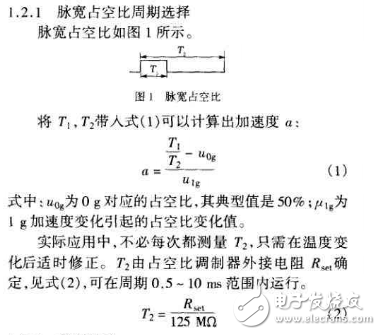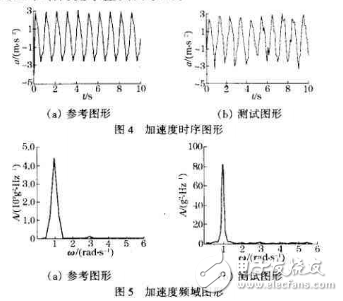This paper describes the application design and integration of a MEMS-based chip ADXL202. The test principle and main parameter design principles of the ADXL202 are introduced, and then a wireless acceleration sensor is integrated and tested. The experimental results show that the ADXL202 is very suitable for the measurement of civil engineering structures with slower frequency changes and less acceleration. The wireless acceleration sensor composed of ADXL202 is easy to install and dismantle and is suitable for civil engineering structure monitoring.
Measuring principle and parameter design of MEMS chip ADXL202The ADXL202 is a low cost, low power, fully functional dual axis acceleration sensor. It uses a polysilicon-based MEMS sensor and signal control loop for open-loop measurement. The measurement results are directly output as analog signals or digital signals converted to pulse width duty cycles. The ADXL202 measures positive and negative acceleration with a maximum measurement range of ±2 g. The ADXL202 measures static acceleration and can also be used as a slope measurement.
Measuring principle
The ADXL202 utilizes advanced MEMS technology to form a two-axis accelerometer system based on a single integrated circuit. The sensor uses a polysilicon structure that is micromachined on a silicon wafer, supported by elastic elements of polysilicon and provides the resistance needed to balance the acceleration. The structural deflection is measured by a variable capacitance consisting of a separate fixed plate and a central plate attached to the moving object. The accelerometer changes the distance between the central plate and the fixed plate after the acceleration force, thereby changing The balance of their variable capacitance is such that the amplitude of the output square wave is proportional to the acceleration, and the phase demodulation technique is used to extract information and determine the direction of acceleration.
The output of the demodulator is realized by a 32 kΩ fixed resistor in the function module, and then filtered by a filter circuit with a set bandwidth to improve the measurement accuracy and effectively prevent frequency aliasing. After low-pass filtering, the output analog voltage signal is converted to a square wave whose duty cycle is proportional to the acceleration through a DCM (Pulse Width Duty Demodulator). The period T2 of the square wave can be set by a resistor Rset. This square wave can be sent directly to the microcontroller for processing to obtain the value of the acceleration. When using a single-chip microcomputer for data processing, a counter or other method can be used to measure the period T2 of the square wave and the width T1 of the pulse, where T1 and T2 are as shown in Fig. 1.
Parameter design
Pulse width duty cycle selection

Bandwidth design
The bandwidth selection of the ADXL202 determines the measurement accuracy. The analog signal output of the ADXL202 has a typical 5 kHz bandwidth and the signal needs to be filtered to reduce frequency aliasing. At the same time, in order to minimize the error of the pulse width duty cycle, the analog bandwidth should be 1/10 lower than the pulse width duty cycle. In practical applications, the analog bandwidth can be increased to 1/2 of the pulse width duty cycle frequency, but this may result in an increase in the dynamic error of the pulse width duty cycle. The ADXL202 has Xfilt and Yfilt pins that can be externally connected to set the frequency band.

Hardware integration
The wireless sensor is modular in design, and Figure 3 is an integrated block diagram of the wireless acceleration sensor. The detection unit is an important component of the wireless acceleration sensor. It is composed of ADXL202 and its auxiliary circuits. It is used to detect structural acceleration changes and transmit the output to the micro-processing unit. The micro-processing unit realizes sensor signal acquisition and pre-processing. The wireless module performs data exchange to realize data transmission; the wireless module is used to transmit sensor data through wireless communication; the wireless acceleration sensor uses a lithium battery with a charging circuit as a power unit for energy supply.

programming
The data acquisition and processing program of the ADXL202 is embedded in the microprocessor unit. On the one hand, the program implements calibration, acquisition and pre-processing of the ADXL202; on the one hand, the processed data is transmitted to the computer and further processed by the relevant software. The specific program flow is: the acceleration sensor is corrected during power-on initialization, and then the software is always waiting to receive the computer handshake protocol state. Once the protocol is received, the received data type is analyzed, and the corresponding operation is performed according to the data type.
experiment analysisThe wireless sensor based on ADXL202 was tested, mainly to test the dynamic acceleration change. The dynamic acceleration model was used to simulate the low-frequency vibration signal of civil structure. The model can generate the set acceleration waveform as a reference for wireless acceleration sensor measurement. Waveform. The model was designed to generate a sine wave acceleration with a frequency of 1 Hz. From the model reference and the test timing waveform, Figure 4 shows that the two agree well. Figure 5 shows the model reference and test frequency domain characteristics: the actual acceleration peak frequency of the model is 0. 9825 Hz, and the model test acceleration peak frequency is 0. 9766 Hz. This small difference can meet the civil structure health monitoring needs. of.

Repeated debugging of the wireless acceleration sensor shows that the ADXL202 is very suitable for the measurement of geotechnical structures with slower frequency changes and less acceleration. Its miniaturization, low power consumption, etc. are suitable for the integration of wireless sensing devices. The wireless acceleration sensor composed of ADXL202 has the characteristics of accurate measurement and easy installation and removal.
24W Wall-Mounted Power Adapter
24W Wall-Mounted Power Adapter,26V1A Power Adapter For Messager,Power Adaptor For Air Purifier,12V2A Adapter Wall Type Charger
Guangdong Mingxin Power Technologies Co.,Ltd. , https://www.mxpowersupply.com
